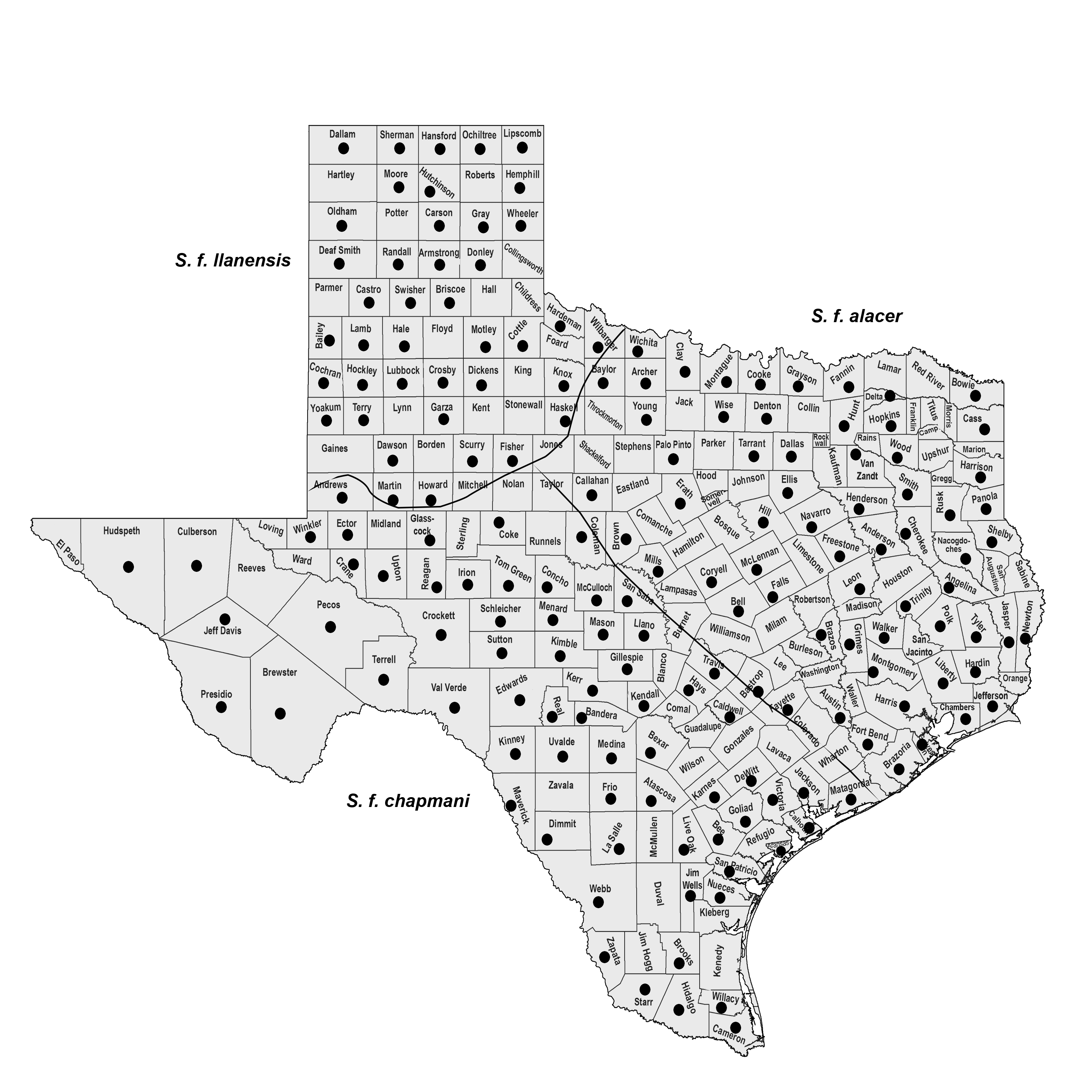EASTERN COTTONTAIL
Sylvilagus floridanus (J. A. Allen 1890)
Order Lagomorpha : Family Leporidae
DESCRIPTION. A moderately large, rusty brown cottontail with relatively short ears and large hind feet (ears 50%–60% as long as hind feet). Upperparts deep ochraceous buff, heavily lined with blackish, giving a rusty or reddish-brown effect; sides paler and grayer; top of tail like back; rump dingy grayish, not conspicuously different from back; front and sides of legs deep, rich, rusty reddish; underside of neck buff or ochraceous buff, rest of underparts, including tail, white. Differs from S. audubonii, with which its range overlaps, in having small, smoothly rounded bullae (rather than large and rough) and relatively and actually shorter ears. Averages for external measurement: total length, 418 mm; tail, 56 mm; hind foot, 92 mm; ear, 52 mm. Weight, 1–2 kg.

DISTRIBUTION. Occurs throughout the state.

SUBSPECIES. Sylvilagus f. alacer in eastern Texas; S. f. chapmani in the central, southern, and western parts of the state; and S. f. llanensis on the Llano Estacado.
HABITS. Like other cottontails, eastern cottontails are a denizen of brushland and marginal areas and seldom venture far from brushy cover. In central Texas, it commonly frequents brush-dotted pastures, the brushy edges of cultivated fields, and well-drained streamsides. Occasionally, it inhabits poorly drained bottomlands with the swamp rabbit. In many places, it is common along country roads, especially where the sides are grown up to dense vegetation and adjoining areas are heavily grazed or farmed.
These cottontails are active largely in the twilight hours and at night, when they venture into open pastures, meadows, or lawns to forage. They frequently live on the edges of towns and feed in gardens and flowerbeds. In the daytime, they rest in beds in nearby thickets or in underground burrows and small culverts. On the coastal prairies of Texas, a population density of one cottontail to 1.8 ha (4.5 acres) is not unusual.
The food is variable with the season. They feed on a variety of grasses and forbs, but when such vegetation is scarce, they eat the twigs and bark of shrubs and small trees. These rabbits are not sociable and are seldom seen feeding together.
Eastern cottontails are prolific breeders. In southern Texas the breeding season is yearlong, although the frequency of breeding does fluctuate throughout the year. Breeding activity is stimulated by environmental factors, such as temperature and rainfall, which affect the growth of vegetation. As many as four or five litters of one to eight young (average four) may be reared yearly. The gestation period is 28–29 days. The young are blind and helpless at birth but grow rapidly; when 4–5 months old they are distinguished from adults only with difficulty. Young females born early in the year may mature sexually and produce young in their first summer, but ordinarily they do not breed until their second summer.
These cottontails are preyed upon by merlins, barn owls, red-tailed hawks, opossums, coyotes, foxes, and weasels. Doubtless, many other species can be added to the list.
POPULATION STATUS. Common. Except for the northeastern region of Texas, the eastern cottontail occurs in large numbers throughout the state.
CONSERVATION STATUS. The IUCN status is listed as least concern, and the eastern cottontail does not appear on the federal or state lists of concerned species. It appears to be increasing its distribution throughout the United States. This species has no major conservation issues.
From The Mammals of Texas, Seventh Edition by David J. Schmidly and Robert D. Bradley, copyright © 1994, 2004, 2016. Courtesy of the University of Texas Press.
Natural Science Research Laboratory
-
Address
Museum of Texas Tech University, 3301 4th street, Lubbock, TX 79409 -
Phone
806.742.2486 -
Email
nsrl.museum@ttu.edu

